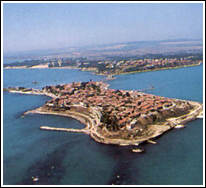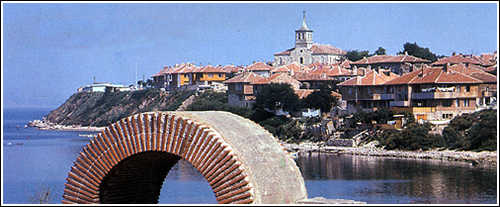 |
|
|
|
|
There was a Thracian settlement called Messambria. The presence of Thracians is confirmed by the presence of the discovered Thracian fortress walls. In 513 BC Greek colonizers from Megara, Vizantion and Halkedon settled in Messambria. They built the fortress walls, theatre, gymnasion, temples of Apolon, Zeus and Dionissius. The prosperity of the town began from 4th century BC and continued till the conquest of the Blacksea colonies from the Romans. In 72 BC the legions of Mark Lukul conquered Messambria and in the course of four centuries of Roman dominance the town declined. After the decline of the Roman Empire in 395, the sea town remained within the boundaries of Byzantium and gradually turned into a church and economic centre with an important strategic significance. In 5-6 century Messambria (the Byzantine name of the town) was encircled by a new fortress wall. It has been preserved until present. During the early Byzantine period a lot of churches were built. Such are the three-ship basilicas "St Sofia" and "St Mary Eleusa". In 681 the Bulgarian State was found. For the first time in 812 Khan Krum conquered after two-weeks siege Messembria and it was included within the boundaries of Bulgaria. The contemporary name of the town - Nessebur dates back since then.
The period 11th - 14th century was quite turbulent for Nessebur. The town, situated in the region of the border, it passed in the dominion at times of Bulgaria, at times of Byzantium. Nessebur reached its apogee during the rule of tha Bulgarian Tsar Ivan Alexandar (1331 - 1371). It occupied an active part in the trade of Bulgaria with the marine republics of Venice, Genova and Doubrovnik. In 1366 after a continuous siege Nessebur was occupied from the knights of Amedei 6 Savoiski. The next year they gave with ramson the town to Byzantium. About a century later (1453) Nessebur was occupied by the Osman Turk Karadja Beg and it was included in their state. The evidences about the history of the settlement from 15 - 19 century are quite scanty. In 16 -18 century in the outskirts of the town there was a big shipyard which belonged to the Sultan.

The main means of living of the population were fishing and trade with fish, vine-growing and extraction of salt. During the Renaissance (18th - 19th century ) in Nessebur beautiful two-storey houses were built - wonderful examples of the so called " blacksea house " - with broken up facades, bow windows, balconies and a lot of windows. After the Liberation (1878) the rich historical past of Nessebur attracted the attention of archaeologists and historians.
In 1920 the first organized archaelogical excavations began. From 1956 Nessebur was declared an archaeological and architectural reserve. In 1983 the old town of Nessebur was included in the list of the world heritage under the eagies of UNESCO.